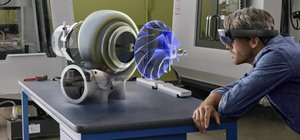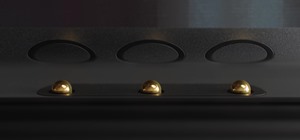
It is almost indisputable that smartglasses and head-worn displays are the future of augmented reality. However, at this precise moment, they are still a very niche market.
Those who have been in the presence of a HoloLens, Meta 2, or Magic Leap One have witnessed how powerful AR experiences can already be in headsets. Then there are those who work at companies who have deployed Vuzix, ODG, or Daqri smartglasses and can attest to how augmented reality has made tedious work tasks easier.
There's a widely shared vision of a future where augmented reality is ever-present. Navigation prompts appear in front of our eyes as we walk down the street. Every street corner looks like Times Square or Tokyo, with digital advertisements covering every square inch, vying for our attention. The idea of a desktop as a workspace, now confined to 2D monitors, returns to our actual, horizontally-situated desktop, with virtual graphs and models spilling across and floating above its surface. Smartglasses and other AR-centric devices are what enable that future.
- Previous: NR30's Top Mobile AR Leaders to Watch in 2018
- Next Up: NR30's Top AR Software Development Leaders to Watch in 2018
Some experts say that we're still five to ten years away from AR hardware being mature enough to fulfill that utopian ideal, but technology can improve exponentially in that period. Remember, just ten years ago app stores had not yet opened their digital doors. Now, apps made for smartphones have created billion-dollar companies and fuel entire economies.
With that context, let's recognize this year's NR30 hardware leaders — people working in AR today who have made great strides this year in pushing the boundaries of tomorrow. We may very well look back at this list a decade from now and realize that 2018 was when the wave broke — that these same individuals were the pioneers who were responsible for the next big revolution in computing.
Rony Abovitz — Magic Leap
The promise of the company is embedded in the company's name — Magic Leap — a seemingly impossible jump into a different reality, seamlessly mapped over the real world. That's what Rony Abovitz sought to do when he founded his augmented reality company (he refers to it as "spatial computing") back in 2010. The goal was to turn his many science fiction-powered aspirations into interactive experiences and tools that could be utilized by anyone on the planet.

Envisioning AR that has the same ease of use and simplicity one might face while picking up a real coffee cup or writing on a physical whiteboard — the Magic Leap One has been a long time coming. Now, it has finally found its way into the hands of a small legion of developers eager to test the boundaries of what is, for now, the cutting edge of wearable augmented reality hardware.
However, when the device finally arrived in August, for many, it just didn't live up to the hype that had been drummed up for years by Abovitz and his marketing team. That hype machine was also fueled in part by reports from various, often famous friends of the company who had been given early demos and publicly raved about it under the mystery-saddled framework of non-disclosure agreements.

Initial reviews from a small group of news sites given early access to the device were lukewarm at best. But the real hammer came down when Oculus founder Palmer Luckey directed his well-honed technical eye at the device in detail, ultimately deeming the product "slightly better than Hololens in some ways, slightly worse in others."
The following weeks saw Abovitz use Twitter to push back at critics while simultaneously working to foster the group of developers who are enthusiastic about the Magic Leap One and the possibilities around its platform. In addition to a small collective of developers now working with the device, Magic Leap also has partnerships with the likes of AT&T, the NBA, and various entertainment studios with an eye toward developing high-end AR content. With the addition of the notoriously addictive Angry Birds franchise to its app lineup this fall, Magic Leap One is even aiming at Apple where it hurts.
And while big-name partnerships are always great for a new startup, none of those relationships appear to add up to anything tangible in the way of profits that will help investors get a return on the billions invested in the company. In a tech landscape primarily driven by rapid cycles of innovation, it seems Abovitz is hoping to play the long game. It's a strategy that could work, but based on the company's post-launch profile, that long-term strategy isn't off to a great start.
But despite what some have characterized as a failure to deliver on big promises, what Abovitz has managed to do is to bring the spirit of showmanship and bigger expectations to AR. Beyond cute mobile app AR filters and concept videos, what Magic Leap revealed, via the tech world's disappointment, is a desire to use what Magic Leap seemed to promise: a brand new world of fully interactive virtual interfaces and objects more powerful than anything we've seen before.
The Magic Leap One may only be an iterative step ahead of previous devices, but it's nevertheless a step in the right direction. And its chief cheerleader, Abovitz, is giving a young and still largely unformed AR space the high-profile advocate it sorely needs as it trudges inexorably toward mainstream adoption.
Ever since Apple co-founder Steve Jobs passed away, we've watched some executives stride stages at various conferences and events, taking the wraps off the next new product in a number of categories. And in almost all cases, no matter how cool the actual product, there seems to be little in the way of true excitement matching that of a new product release from Apple as presented with the theatrical flair of Jobs in the past. No, Abovitz doesn't yet have a reputation for pacing stages while unveiling the future, but he has managed to capture the imagination of the public using something else: social media.
Through that game-changing medium — which now can result in powerful executives losing long-held corporate roles or fuel another's political rise on the world stage — Abovitz has seeded the mainstream market with ideas, priming the world to embrace augmented reality in a way that no other CEO in the space has.
Sure, the Magic Leap One didn't deliver that holiest of holy grails, that is, a tiny pair of AR smartglasses indistinguishable from everyday eyeglasses. But it does the next best thing; it lets us take a powerful AR headset anywhere, free of a stationary PC, and with no need to hold a square device in front of us as we squint and squirm in position to experience immersive computing.
It's far too early to predict the fate of the Magic Leap One or the multi-billion dollar-backed company. And we'll get another signal as to just how popular (or not) the device is with developers next month when Magic Leap hosts its first L.E.A.P. conference in Los Angeles.
But aside from all the unanswered questions (How long will the funding last without significant profits? If it's an entertainment-focused device, how and when will future, non-developer-centric versions of the device come out, and at what price?), what's undeniable is that Abovitz has presented us with what can arguably be considered the best-designed "vision" of what AR can be "today," before we do get those ideal, magically tiny AR smartglasses everyone has their sights set on.
Alex Kipman — Microsoft
It might not be a stretch to call Alex Kipman (pictured at the top of this article), technical fellow at Microsoft, the godfather of modern augmented reality based on his work as the visionary inventor of the HoloLens.
The Brazil native joined Microsoft's Visual Studio in 2001 after graduating from the Rochester Institute of Technology. He rose to acclaim in 2010 with the invention of Kinect, the motion-sensing camera that debuted with the Xbox 360 game console, and would go on to power the depth-sensing superpowers of the HoloLens.
HoloLens was born out of Kipman's frustration in working with two-dimensional displays. Kipman and a team of 20 designers and engineers began working on the prototypes of what would become the HoloLens in 2012. The HoloLens made its public debut at Microsoft's Windows 10 Event in January 2015, with Kipman serving as its escort for the evening. While the $3,000 device has only sold about 50,000 units as of May 2018, many credit the headset with establishing the mixed reality wearables industry, particularly with its adoption among enterprise customers.
Kipman's innovations place him in a rarefied air that extends beyond augmented reality and to the upper echelons of the tech world. Time magazine ranked Kipman as one of the top 25 nerds of 2010, alongside Steve Jobs, Mark Zuckerberg, and Elon Musk, for bringing the world the Kinect, and he was a finalist for the 2018 European Inventor Award for his work on the HoloLens.
With a new version of the Kinect sensor and a second-generation edition of HoloLens reportedly arriving in 2019, Kipman's direct and indirect influence on the industry is poised to extend even further.
Paul Travers — Vuzix
Augmented reality is still an emerging technology, but Paul Travers, founder and CEO of Vuzix, has been working in the field since 2010. While his company has concentrated on enterprise-focused devices, Travers and company are preparing to take on the consumer sector.

A graduate of Canton ATC and Clarkson University with more than 30 years of experience in consumer electronics, Travers easily earns the label of "serial entrepreneur." Travers started his professional career at Eastman Kodak but left to found Forte Sound, which initially consisted of him making sound cards for PCs out of his basement, before licensing his technology to Advanced Micro Devices. He then started a USB connectivity company, Etek Labs, which he eventually sold to Belkin. He followed that up with Forte Technologies, a VR headset maker.
Then, in 1997, he founded Interactive Imaging Systems, the company that would eventually be called Vuzix. The company made night vision systems for the military and personal video displays until it made its first augmented reality wearable, the STAR-1200, in 2010.
Today, Travers and company offer smartglasses in a much more compact form factor than that first device. The company markets its M-series of smartglasses towards enterprise, with companies like John Deere and DHL among its clients. The company has also developed a tethered version of the M-300 for Toshiba to sell to enterprise customers.
But it's the Vuzix Blade, with a design that takes more influence from Oakley than Star Trek and includes the powers of Amazon's Alexa, that represents the company's pivot towards consumers. Vuzix is currently accepting preorders for Blade developer kits, but the company is already in line for the Qualcomm Snapdragon XR1, a chip dedicated to augmented reality devices, for the 2019 edition of the Blade.
We talked to Travers about this last year in AR and how he got into the field. Below are his lightly edited responses.
Describe your first time experiencing AR or VR?
The first time I experienced VR was in the early 1990s at an arcade in the Thousand Islands in Northern New York. I was playing Dactyl Nightmare from Virtuality. It was very intriguing, but expensive for the short time I got to play.
At the time, there were no consumer VR products. The game was compelling enough though that it convinced me to start my own company making VR headsets for the consumer. The second time I tried VR was while using the VFX1 from Forte Technologies, my first VR company. This second time was thrilling for me since it was something our team had built.
The first time I experienced AR/MR was at the World's Fair in Aichi Prefecture, Japan. Vuzix was contracted by Hitachi to build a set of mixed reality binoculars for their pavilion. The line was for as many as 10,000 people a day. While riding the ride, people were screaming with excitement about the experience. The ride was incredibly interactive, and the virtual objects felt so real — I was beyond sold that the idea of mixing the real world with the digital world was going to change almost every part of life.
What's the most important thing that happened in AR in the last 12 months?
ARKit and ARCore. These tools, and the applications that use them, are teaching people a brand new way to use their mobile devices and showing users the value of connecting the digital world with the real world. Changing people's behavior is one of the most difficult tasks to opening a new market, and ARKit and ARCore are teaching everyone that there is value here, and the AR applications coming from them are delivering on this value.
Ralph Osterhout — ODG
With all apologies to the rest of the names on this list, Ralph Osterhout has the coolest résumé entry, having designed devices for James Bond films of yore through Tekna, makers of scuba equipment, products for the US Department of Defense, as well as general consumer products. One of those devices was an early version of the PVS-7 night vision goggles, through another startup of his called S-Tron. He continued developing military equipment, including helmet-mounted displays, in another company that he founded called Inter-4.

Later, he went on to start Osterhout Design Group (ODG) in 1999, maintaining a focus on military technology, with night-vision goggles, handheld biometric computers, portable servers, and drones among its product portfolio, before applying his experience (evident in 41 patents issued for optics) toward smartglasses.
In 2016, ODG closed a $58 million Series A funding round to accelerate its production capacity and build and ship new products. The company is now on its tenth generation of smartglasses, the ODG R-9. The THX-certified device boasts 50 degrees field of view, six degrees of freedom tracking, and SLAM.
Despite his proximity to agent 007 and his fantastic toys, Osterhout is also a bit of a realist, stating at CES 2017 that smartglasses cool enough for Bond are not yet feasible. But ODG is getting close.
We talked to Osterhout about his inspiration to join the AR field. Below is his lightly edited response.
What was your initial inspiration for working on AR hardware?
In 1984, I was part of the team that designed the PVS-7 night vision goggles, helping to "capture the night." I thought, "Wouldn't it be great to help build glasses that can connect you and capture the day?" Since that time, I've been maniacally focused on binocular, dual-eye, integrated smartglasses — head-worn computers that provide access to information anywhere via augmented reality. Smartglasses are the next mobile frontier and augmented reality is helping to enable that.
Joseph Mikhail — Meta
Meta has become a familiar name in the AR community, but its chief revenue officer, Joe Mikhail, only joined the company in an operational capacity about a year ago. A member of Meta's board of directors since 2015, Mikhail is no stranger to the intricacies of AR and what it takes to extend the startup's reach far beyond the insider and enthusiast contingent of the AR community.

Raised in the tech-obsessed confines of Silicon Valley, Mikhail came to Meta from Lenovo, where he was director of worldwide open innovation, and before that, he led corporate strategy and innovation at Flex (formerly Flextronics).
But Mikhail isn't just a business mind, he's a true AR geek, with a deep passion for the space and its future beyond the current state of the art. That vision and passion will be even more critical now that companies like Magic Leap have joined the fray, and Microsoft's HoloLens prepares to release an updated version of its hardware. Luckily for Meta, Mikhail's experience with mobile hardware and software, and putting those tools to work for mainstream success, match his enthusiasm and insight into AR.
We talked to Mikhail about his impressions of the AR field over the last 12 months. Below are his lightly edited responses.
The thing you dislike most about currently available AR hardware or software?
The lack of standards makes AR projects live in silos. Once industry aligns on this, AR will be primed for broad ecosystem growth and mass adoption. Maybe this is an opportunity rather than a challenge!
What's the most important thing that happened in AR in the last 12 months.
The introduction of high-valued AR solutions. A shift from developer kits for R&D to applications for business units.
Kevin Zhong — DreamWorld
The story of Kevin Zhong's impressive mobile AR device called DreamGlass began with a rocky separation from Meta, the company where he previously worked as a senior optical engineer. About a year after his departure in 2016, Zhong announced the creation of DreamGlass, a cheaper, and more mobile-friendly competitor to the Meta 2 headset. Soon after, Meta filed a lawsuit against Zhong and his company DreamWorld, alleging misappropriation of trade secrets and confidential information.

However, it didn't take long for the two companies to reach a settlement, paving the way for Zhong to push forward with the release of his DreamGlass device, which can provide AR experiences while tethered to a PC or connected to a mobile phone. In many ways, what Zhong's company is providing is an early version of the ideal AR headset many companies have been working toward.
In short, it's a fully realized AR computing environment, connected to the web, that can deliver much of the promise of AR in what will likely be the most popular mobile AR dynamic until we get lightweight AR smartglasses.
At the most recent AWE conference, Zhong was on the ground giving personal demonstrations to anyone who had time to give the device a try, and most walked away fairly surprised by the power of the DreamGlass. Now the only question is whether Zhong will be able to transform his energy and fast moving approach into scale as the market begins to fill up with competitors with much deeper pockets and massive marketing budgets.
We talked to Zhong about his impressions of the AR field and how he got into it. Below are his lightly edited responses.
The moment you knew AR was the future?
Despite its limitations, Google Glass raised a lot of interest from the mainstream and received a lot of useful feedback for the AR industry. That's when I knew AR was the future. I have a lot of respect for early AR products such as Google Glass and HoloLens. I think they built the foundation for the growth of the current AR environment.
What's the most important thing that happened in AR in the last 12 months.
Although I am not a big fan of phone-based AR, I think the most important thing is the release of ARKit and ARcore. It gently touched the mainstream smartphone user and told them, even in a very limited scope, how fun AR can be. This is very important. Attention from the mainstream will help motivate AR companies, and the giants in consumer electronics, to invest more in AR technology.
Adario Strange and Tommy Palladino contributed to this report.
Just updated your iPhone? You'll find new features for Podcasts, News, Books, and TV, as well as important security improvements and fresh wallpapers. Find out what's new and changed on your iPhone with the iOS 17.5 update.
























Be the First to Comment
Share Your Thoughts